UPDATE: August 5, 2018: Annette visited her birth house in North Bay today. Cecile was supposed to join her but cancelled due to health reasons. The story is here.
UPDATE: As of November 19th, 2017, the birth house and museum of the Dionne Quintuplets has been moved to the North Bay waterfront, installed on Oak Street (between the Heritage Museum and Marina Point seniors residence).
The museum has been closed since 2015. Local council paid for the $150,000 move and a group, the Dionne Quints Heritage Board, is negotiating with the city – and raising money – to operate the home and conserve its contents. expects to re-open the museum in 2018.
If you’d like to donate to their fundraising efforts, click here.
********
[pullquote]
It’s hard to know who to trust. ~ Elzire Dionne
[/pullquote]In the middle of the parking lot of the North Bay & District Chamber of Commerce, at the busy intersection of highways 11 and 17, a modest frame house sits like a fish out of water. A prominent sign identifies it as The Dionne Quints Museum. Thousands of cars stream by, but few stop anymore.
On May 28, 1934, Franco-Ontariens Elzire and Oliva Dionne gave birth to five identical girls in this house in Corbeil, Ontario. Yvonne, Marie, Cecile, Annette and Emilie joined five existing children. Four more would follow. Local country doctor Allan Roy Dafoe attended the birth, spontaneously ascending to international superstardom.
Their miraculous birth offered a bright spot in the crushing darkness of the Great Depression. The intimate details of their daily lives – what they ate, how they grew, the toys they played with – made front page headlines for the next nine years. They became the most photographed, sought-after children in the world.
And everyone wanted a piece of the action. Promoters and showmen from across North America descended on the Dionne homestead. A few days after their birth, their father, under pressure to support a large family, signed an agreement to exhibit the quints at the World’s Fair in Chicago. (Source: A. Wallace)
The Ontario government – bolstered by an outraged public – became concerned about the safety and exploitation of the quints at the hand of Oliva. On July 27th 1934, Premier Hepburn’s attorney general, Arthur Roebuck, obtained a judicial order removing the quintuplets from their parents’ authority. The following year, the Liberal government introduced a bill in the Ontario legislature to make the babies wards of the Crown until their 18th birthday. The Dionne Quintuplet Guardianship Act passed without amendment and the Dionnes became parents in name only.
Source: The Evening Independent, March, 1935
In order to accommodate, study, and display the quints, the government constructed the Dafoe nursery, aka Quintland, a hospital compound for the children and their caretakers directly opposite the Dionne homestead.
Dr. Dafoe described the compound:
…at present they live in a fully equipped, comfortable home, containing all modern conveniences.
Their little estate is made up of about seven acres, and is surrounded by a heavy metal fence seven feet high and topped with barbed wire.
The grounds within are prettily landscaped and contain many planted trees, a tiny garden, patches of lawn, and three buildings. At one side of the children’s house, or main building, is the observation playground’s structure. Here the general public may watch their play (through glass and a fine screen) from a protected [dark] corridor. By this means the observation periods are carried out with minimum noise for, and distraction of, the children.
Source: North Himsworth Museum
Nine permanent staff included two nurses, one teacher, three policemen, one housekeeper, and two maids. The nurses were responsible for “the care and training of the children and for carrying out the plans laid down for their early education.” They performed the duties of a surrogate mother. Police kept staff locked in and undesirables, including the remaining Dionne family, out. Dr. Dafoe was not only concerned about the potential for abduction, but about their exposure to germs.
[pullquote]The general protective measures include isolation from the public and wearing of face masks and gowns by the attendants caring for the children.[/pullquote]
With thousands of visitors and two “shows” every day, Dr. Dafoe described the quints’ care as carefully regulated. “They eat, sleep, and play at regular hours and nothing is allowed to interfere with this routine.” Each day was divided into 27 precise segments such as: 8:45am “drink of water,” 10:45am “put away toys,” and 4:30pm “directed play.” A freakish experiment in child-rearing, every response, action, and emotion was meticulously recorded, analyzed, and shared with the press. Dr. Dafoe was king of the Quintland castle.
The children attracted 3 million visitors to North Bay and area during the peak of the depression. The associated cottage industry provided employment for thousands of locals.
From 3,000 to 6,000 people daily crowd the roadway before the Dafoe nursery. Business booms, land is sold at unheard-of figures. Inns, hotels, tourist camps are full every night. The resultant jobs have almost entirely erased relief rolls…Every hotel room and every bed available for tourists within 10 miles is occupied…I counted license plates from 31 states and Canadian provinces at one “showing”….Parking is free, and so is the “show,” but if you want postcards and souvenirs, refreshments and gifts, you will pay well. Source: City of North Bay Archives
One financial expert described the babies as “a perfect example of a benevolent and natural monopoly with no living competitors.” Locals referred to the quints as “the nuggets.”
Note: This video is mute
http://www.youtube.com/watch?v=OvoRoqYZc20
The quints were early global celebrities, shilling everything from food and personal hygiene items to automobiles and pocket knives. The fees and royalties earned through endorsements and movies were to be kept in trust by the government, and invested wisely, for the girls until their 18th birthdays. In November 1937, Dr. Dafoe estimated their worth at $500,000 (Source: The Canadian Medical Association Journal, Nov. 1937).
And Dafoe believed that earning money – as much as possible, as quickly as possible – was imperative to their long-term well-being.
[pullquote]They can’t live the normal life of ordinary individuals so there isn’t any point in bringing them up as ordinary children…They must learn to be looked at, talked about, written to and studied…And because they will always have to buy their privacy and pay dearly for it…we are trying to build up sufficient funds to make it possible for them to have peace and freedom as the years go by.[/pullquote]
Everyday life for the quints was extraordinary. For the first year of their lives they knew only each other. For the first five years, with the exception of one ten-minute ride in their father’s car, they never left the hospital playground. Their trip to Toronto in 1939 to meet King George VI was the first of only a handful of outings.
In 1943, after nine years of legal wrangling, coupled with the waning popularity of the children and English-Franco tensions, Oliva and Elzire regained control of the quints. Dr. Dafoe, their surrogate father, was relieved of his guardianship duties and a year later was dead from pneumonia. Using money from their trust fund, an 18-room mansion (the “big house”) was built next to the existing nursery to house the reunited Dionne family and staff. The nursery transformed into a Catholic school and ten hand-picked French Canadian girls formed their first social circle.
“It’s lovely to have mamma and daddy always near. I am so happy,” eldest Yvonne told the press. “It is just like the picture books, our new home is so nice.” But life was not easy for a family chock-full of bitterness, resentment, and payback. Twenty years later that sentiment would be revised by Annette, Cecile and Yvonne: “It was the saddest home we have ever known.”
With few social or life skills, and continuing under close public scrutiny, the quints left home at eighteen to attend the convent of the Sisters of the Assumption at Nicolet, Quebec. Marriage, children, divorces, estrangements, and death ensued.
Emilie died at age 20 of an epileptic seizure. Marie died alone and alcoholic, the victim of a blood clot. The remaining three lived together in St. Bruno, Quebec, existing on a few hundred dollars a month. They severed all contact with their parents and other siblings.
In 1998, Annette, Cecile and Yvonne (who died in 2001) received $4-million in compensation from the Ontario government for their childhood exploitation.
Oliva and Elzire moved out of the big house to a more modest one just up the road. The mansion sat empty for twenty years before its sale and conversion to an old age home.
The rest of Quintland has fallen into quiet sadness and disrepair. The passage of time is slowly granting the five Dionne sisters their wish: to be left alone.
***********
1. Unless otherwise noted, I confirmed/compared my research with Pierre Berton’s The Dionne Years, McClelland & Stewart, 1977
2. Quintland lies between the villages of Corbeil and Callander. The family identified with the rustic Corbeil, which was primarily French-Canadien.
3. Click here for directions, opening hours and admission rates for the Dionne Quints Museum in North Bay and the Callander Bay Museum. The log/frame house that houses the museum was moved to North Bay in the early 1980’s.
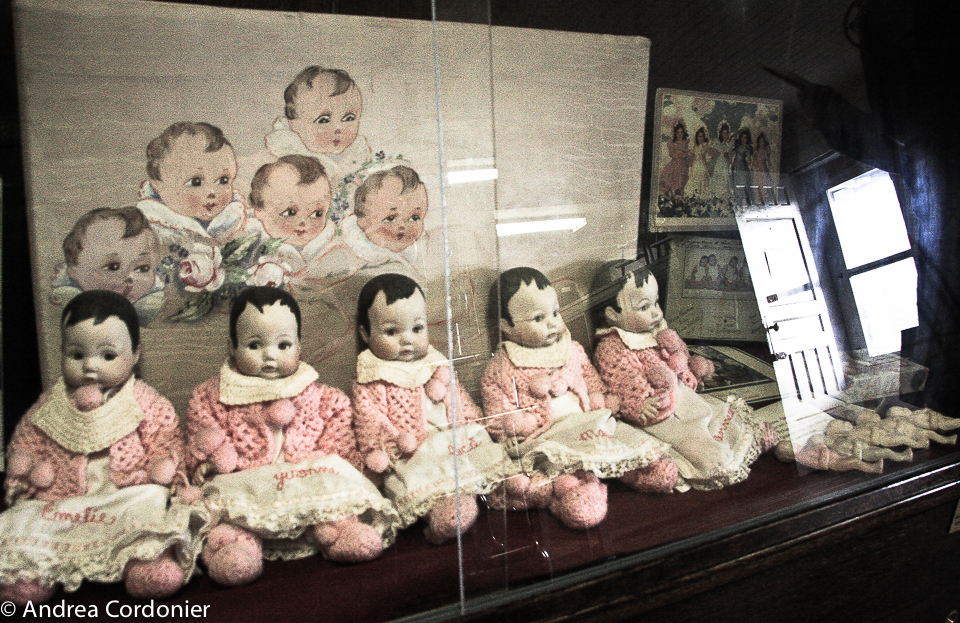
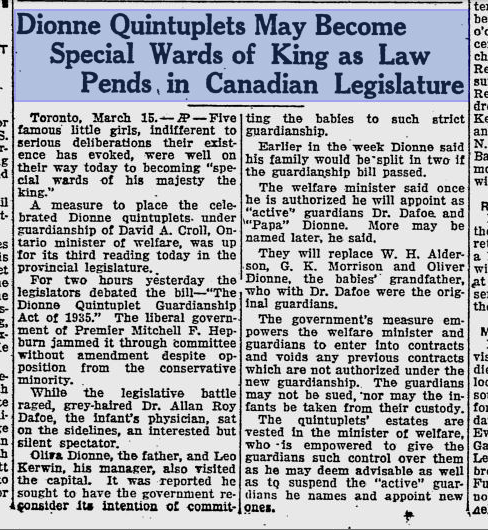

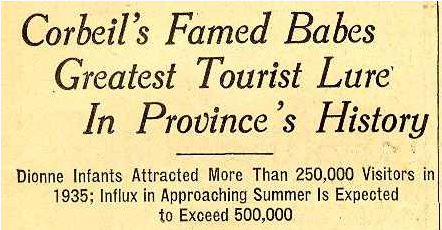
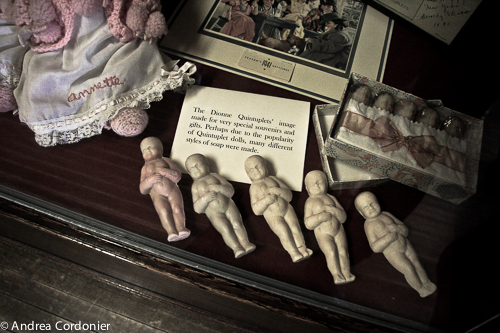
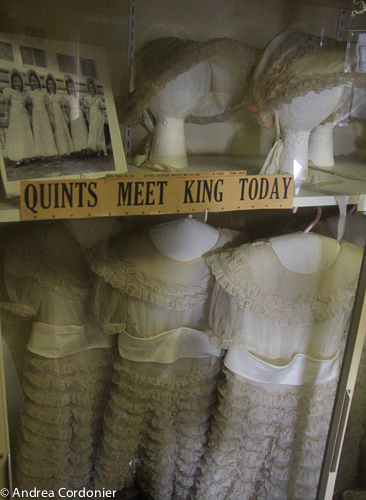



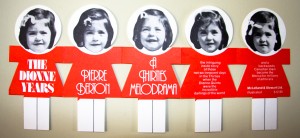
2 responses to “Welcome to Quintland”
So sad. Are any of the quints alive?
Hi Nada –
Yes, it is such a tragic story. Annette and Cecile are still alive (turning 81 this year) and are living in the suburbs of Montreal.
Kindest, Andrea